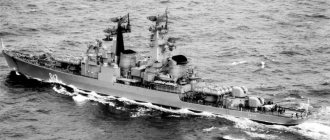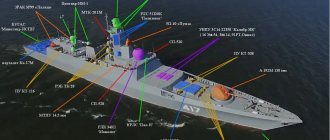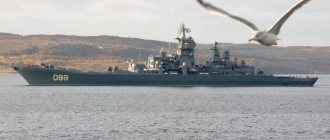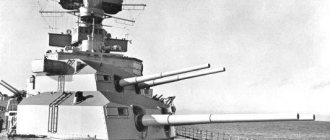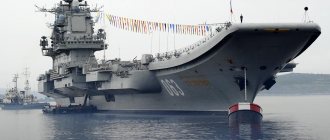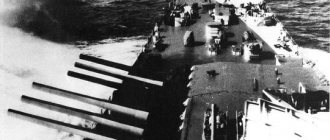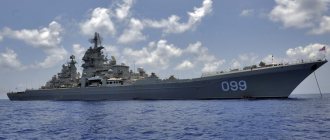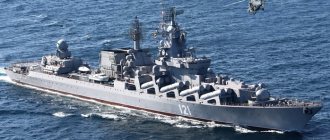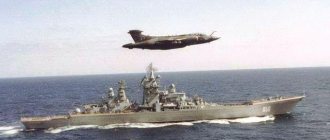After the Second World War, heavy aircraft carriers became a symbol of the naval power of the United States (remember the same Nimitz), but in the USSR the situation was much more complicated. No one could lay claim to the role of main strike force - neither the old artillery cruisers nor the new missile cruisers. And only in the early 70s did the construction of ships begin, the likes of which had never been seen in any navy in the world.
Such ships were the Project 1144 Orlan heavy nuclear-powered missile cruisers, although they are most often called by the name of the lead cruiser - the Kirov class. Most of the Orlans served for a short time, and therefore became a kind of embodiment of the difficult situation of the fleet in the 90s.
History of creation
On March 26, 1974, the first ship of the unique Orlan project was laid down at the Baltic Shipyard in Leningrad.
The Northern Fleet occupies a special place in the structure of the Russian Navy. This is the youngest of all Russian fleets, dating back only to 1933, but at the same time it is also the most powerful. The reason for this is the specific role that the Northern Fleet played during the Cold War. The Baltic and Black Sea fleets turned out to be significantly limited in capabilities due to the characteristics of their home waters - inland seas, while the Pacific and Northern fleets were open ocean fleets. At the same time, from the point of view of security and inaccessibility of bases, it was the fleet in the north of the country that found itself in a more advantageous position, and therefore the main burden of confrontation with potential opponents in the post-war period fell on its shoulders.
That is why, as a rule, new ships appeared in the Northern Fleet first. This was the case with the unique cruisers of Project 1144 - the Orlan type, the first and only surface combatants in Russia with a nuclear power plant. Today, North Sea sailors are the only ones who serve on a ship of this project included in the fleet: the heavy nuclear-powered missile cruiser "Peter the Great" has been their permanent flagship since the late 1990s. And the construction of ships of the Orlan project began on March 26, 1974, when the first cruiser of the series, Kirov, was laid down on the stocks of the Baltic Shipyard in Leningrad.
The history of the creation of these ships begins in 1964, when the leadership of the USSR, inspired by the success of the world's first nuclear-powered surface ship - the icebreaker "Lenin" - and trying to keep up with the United States, which in 1961 introduced the world's first nuclear-powered missile cruiser into the fleet. Long Beach, decided to create its own ship of the same class. According to the original plan, the main target of the new ship was to be enemy missile submarines. That is, in fact, in the USSR they were going to build a nuclear-powered cruiser-raider, which in peacetime would control American SSBNs in places where they were on combat duty, and in wartime would hunt and destroy them.
The scope was serious: the original idea of building nuclear anti-submarine ships provided that for each American missile-carrying submarine there would be a separate “raider”. It turned out that a series of such ships would include at least 35-40 units. On the one hand, the USSR had experience in building large series of ships with nuclear power plants, but on the other hand, these were submarines with much narrower tasks. The country has not yet implemented surface projects of this scale and complexity.
It was the uniqueness of the task posed to the designers of the Leningrad Central Design Bureau No. 53, which in January 1966 was renamed the Northern Design Bureau, and the special conditions that the new project had to meet, that became the reason for the ten-year design period. As a result, the initial displacement of 8,000 tons, which the government and military spoke about, grew more than three times - to almost 26,000 tons. The list of tasks that the ships of the new project were supposed to perform gradually expanded. It became clear that as hunters for US ballistic submarines, they would attract special attention from the enemy, which means they need to be provided with a sufficient number of defensive weapons. Thus, air defense systems and anti-ship missiles were added to the range of purely anti-submarine attack weapons. And the need to ensure long-term autonomy of navigation led to the fact that it was necessary to significantly revise the living conditions for the crew, which could not but affect the increase in displacement.
The preliminary design of the ship of the new project was completed in 1969. But it was not possible to simply move from a sketch to a technical project. On May 25, 1971, another government decree was issued, by which the project of the large anti-submarine ship 1144 "Orlan" was combined with the project of the nuclear missile cruiser 1165 "Fugas", which, in theory, was intended to combat enemy aircraft carrier and ship strike groups. It became clear that the Orlans were no longer anti-submarine ships, albeit very large ones, but rather cruisers, and as a result, the new product was given the final classification of a nuclear-powered missile cruiser.
Finally, in 1972, after all the additions and changes, the technical design of the ship was completed, and two years later the first-born of the series, named Kirov, was laid down at the Baltic Shipyard in Leningrad. The lead cruiser received this name not only in honor of Sergei Kirov, but also as the successor to the first Soviet-built light cruiser, which entered service in 1938. Therefore, the first-born of the surface nuclear military fleet received, along with his name, the honorary title of Red Banner, as well as a stern flag with the image of the Order of the Red Banner of Battle - the award of his predecessor.
Because it’s impossible to completely hide the construction of such a large building - and the greatest length of the “Kirov” was no less than 250 meters! - the ship was impossible, the West very quickly learned that the Soviet Union was building something like a battleship. True, later NATO experts came to the conclusion that it was not a battleship that was being prepared for launch, but the first nuclear-powered missile cruiser in the USSR, and assigned the name “Kirov class” to the project.
The ship turned out to be truly unusual and in many ways innovative for Russian shipbuilding. For example, for the first time they used such a solution as placing the main part of the weapons complex in below-deck rooms: this is how the launchers of the Granit anti-ship missiles and the silos of the S-300 Fort air defense system, a naval modification of the complex, were located. Two five-tube 533-mm torpedo tubes were also hidden on board the cruiser: they were installed on the second deck, and in order to fire torpedoes, it was necessary to open the side ports, which were closed in the stowed position. In addition, the Kirov was equipped with the Osa-MA anti-aircraft missile system, had good artillery weapons - two single-barreled 100-mm AK-100 gun mounts and eight six-barreled 30-mm AK-630M gun mounts - and decent anti-submarine weapons: 12- barrel 213-mm rocket launcher RBU-6000 and two six-barrel 305-mm RBU-1000. Finally, a helicopter detachment was permanently based on board, which could include two Ka-27 or three Ka-25 helicopters.
On December 27, 1977, the nuclear-powered missile cruiser "Kirov", the classification of which by this time had been supplemented with another definition - "heavy" - was launched, and three years later, on December 30, 1980, it entered service. Four years later, the fleet received the second ship of Project 1144, which was significantly different from the lead ship and therefore was formally considered built according to Project 11442 - the heavy nuclear-powered missile cruiser Frunze. In 1988, the sailors received another Project 11442 cruiser, the Kalinin. The fourth and last ship of the series - "Kuibyshev", which was renamed "Yuri Andropov" while still on the slipway - was laid down in 1986 and launched in 1989, but for obvious reasons it entered the operational fleet only nine years later, in 1998 By this time, it had already received a new name - “Peter the Great”, and today it is the only cruiser of the Orlan project that is in combat service.
And the very first of the Orlans, Kirov, which in 1992 received the name Admiral Ushakov, was withdrawn from the fleet in 2002 and is now being prepared for disposal. During more than two decades of his combat service, he experienced a lot. For example, in 1984, when a fire broke out at an ammunition depot in Severomorsk, accompanied by numerous explosions, the Kirov was the only ship that remained in the base harbor. He and only he could, if the explosions had caused the missiles stored in the arsenal to launch and fly towards the city, destroy them with the help of his onboard air defense systems. And five years later, the Kirov was one of the ships that went at full speed to help the Komsomolets submarine, which was sinking in the Norwegian Sea, but did not make it due to a serious breakdown of the propulsion system.
Characteristics of the light cruiser Project 26 (Kirov)
A country:USSRType:Light cruiserDate of issue:Indicated in the textDisplacement:7,970 t (standard), 8,675 t (normal), 9,550 t (full).Length:191.16 mWidth:17.7 mDraft:7.22 mReservations:Side, lower deck and traverses: 50 mm, conning tower: 150 mm, turrets: 50 mmCrew:881 peoplePower point:2 turbo gear units, 6 water tube boilers, total power: 122,500 hp.Travel range:2140 milesMaximum speed:34 knotsWeapons:
- 3x 3x 180 mm guns in MK-3-180 turrets.
- 6x 1x 100 mm universal guns in tower shields.
- 4x 12.7 mm DShK anti-aircraft machine guns
- 6x 45-mm anti-aircraft semi-automatic 21-K
- 2× three-tube 533-mm torpedo tubes 39-Yu
- 164 mines
- depth charges: 20 BB-1 and 30 BM-1
Characteristics are given for the light cruiser "Voroshilov"
Design
The nuclear-powered missile cruiser Kirov has a five-deck hull with a “clipper” stem and large masts in the form of pyramids, traditional for Soviet ships.
To reduce radar visibility, the edges of the superstructures and masts were beveled.
Externally, the cruiser is distinguished by a very long forecastle, which houses missile launcher silos. An antenna for a hydroacoustic complex was placed in the bulbous nose. The design provides, which was unusual for rocket ships of that time, armor - protection of vital components reaches up to 100 mm.
Ships - heroes of sea battlesThe main power plant is two water-cooled double-circuit reactors; there are backup steam boilers, for which there are chimneys in the foremast. When traveling on reserve boilers, the Kirov can reach up to 17 knots - about half the maximum speed.
Cruiser "Kirov"
In the book published in Leningrad, we cannot help but talk about the cruiser Kirov
-
a wonderful ship that defended the city on the Neva during the Great Patriotic War, fought on the Leningrad Front throughout the war and was one of the first among the ships of the Baltic Fleet to be awarded the Order of the Red Banner.
In the early thirties, when Hitler came to power in Germany, the issue of strengthening the defense capability of our country became acute. Programs for the construction of cruisers, submarines and battleships were adopted.
Kirov class ships
light cruisers
in the world in terms of speed and armament , built by domestic shipbuilders in the last pre-war years.
During the Great Patriotic War with Nazi Germany, Kirov-
played an important role.
Kirov
-class cruisers was a success for domestic specialists not only in military shipbuilding, but also in metallurgical, electrical engineering, radio engineering and a number of other industries
industry.
The international situation was deteriorating, shipbuilders had to find ways to speed up the critical construction of the Kirov
and other cruisers of the same type.
Designers of the new cruiser
within the tightest deadlines, we analyzed dozens of projects for modern warships and studied the rich experience of cruiser construction.
The construction of the cruiser
was carried out under the supervision of the outstanding Soviet scientist and shipbuilder, Academician Alexei Nikolaevich Krylov.
The designers were faced with a very difficult task: the ship had to have high firepower and at the same time have excellent maneuverability, high speed, good survivability, and armor protection.
One of the most important issues was the choice of weapons. Design of main battery naval artillery systems
a - 180 mm - began in our country in 1933.
During the development of artillery systems, a very bold idea for those times was born: to install not two, but three guns within the dimensions of a two-gun main caliber turret. This proposal was made in 1934 by the chief designer of the tower project. Moreover, each tower was heavier by about 30 tons, and the standard
displacement - by approximately 300 tons, but the number of main caliber guns increased by 50%. The proposal was accepted.
Talented engineers of the Artillery Maritime Research Institute A. A. Florensky and D. F. Ustinov took part in the design of main caliber artillery systems.
A three-gun 180 mm turret was created
, which, according to ballistic data, had no equal in any of the world's fleets.
The installation and testing of the artillery systems of the new cruiser was supervised by D.F. Ustinov (by that time deputy chief designer of the construction plant).
When designing Kirov
The problem of choosing a dialing system
was very acute . Let's look at this issue in a little more detail.
If we remove the outer plating from the hull of any ship, we will see under it many longitudinal and transverse beams. This is the so-called set, which perceives the forces acting on the ship, applied outside the plane of the skin sheets. Any sheet, from paper to steel, has an amazing property: it provides very high resistance to forces applied in its plane. If the forces are applied perpendicularly or at an angle to its plane, the resistance of the sheet is many times less. Therefore, the ship’s hull is formed not from sheets, but from floors, each of which consists of a steel sheet and a set, i.e., a system of mutually perpendicular beams.
If there are more beams running in the longitudinal direction, then the casting system is called longitudinal.
If, on the contrary, most of the beams are located across the vessel, the framing system is called transverse. Sometimes, say, the sides are built using a transverse system, and the deck and bottom are built using a longitudinal system.
In this case, they say that the recruitment system is mixed. Since the choice of the recruitment system determines one of the most important qualities of the ship - the strength of the hull, the solution to this issue is very important.
On the newly designed cruisers they decided to use a mixed recruitment system
: in the middle part of the hull it is longitudinal, and at the ends - transverse, and, unlike foreign ships,
the size of the spacing, i.e. the distance between adjacent beams of the frame
, was reduced at the ends from 760 to 500 mm, which significantly increased the rigidity of the outer skin and deck, and also increased the strength of the ends of the hull.
Main dimensions, m. …… 191.0×17.66×6.15
Displacement, t … ………….. 9 436
Power of main engines, l. from …….. 113,000
Speed, knots………………………. 36
Crew, people……………………. 872
The cruiser was equipped with the most modern weapons: nine 180-mm guns in three main-caliber turrets, six 100-mm, six 45-mm guns (during
repairs in 1943, the number of 100-mm guns was increased to eight, the number of 37-mm guns was increased to 10, the 45-mm guns were removed and replaced with large-caliber anti-aircraft machine guns).
Initially, the ship was equipped with four 12.7 mm machine guns, two three-tube 533 mm torpedo tubes, four bomb launchers and two bomb releasers.
The armor thickness of the side and deck was 50 mm, the front plate of the turrets was 50 mm, the roof of the turrets was 50 mm, and the conning tower was 150 mm.
At that time, the ships did not yet have radars, so the cruiser was equipped with two Kor-type seaplanes (designed by G. M. Beriev). Their
it was supposed to be launched by means of a catapult and lifted on board by a special crane.
On October 22, 1935, the keel-laying ceremony for the ship took place. The construction of the cruiser caused a nationwide patriotic upsurge. The ship's builders understood the high responsibility that fell on them.
Kirov cruiser were sent to the construction plant.
.
Metallurgists welded steel for the ship, produced sheets and profiles
; at electrical factories in many cities of the country the most complex
electrical equipment, the best defense industry enterprises supplied the cruiser with formidable weapons.
At the construction plant, engineers and workers proposed original technical solutions aimed at reducing the construction time of the ship. With the help of scientists, new technological processes were developed and immediately used to speed up the assembly of the body.
In those years, the main method of connecting structures was riveting
electric welding
was partially used , which made it possible to significantly speed up
the hull assembly work
.
For the first time in the history of Soviet shipbuilding, while the ship was on the slipway, boilers and mechanisms were loaded and mounted on it, which required the creation of powerful cargo vehicles. But this decision made it possible to meet the extremely short deadlines for the construction of the ship.
The builders launched the ship on November 30, 1936 - on the second anniversary of the death of S. M. Kirov (killed on December 1, 1934).
On September 26, 1938, the ship’s best gunner N.S. Debelov (later captain of the 1st rank and teacher at the Leningrad Shipbuilding Institute) raised the naval flag over the cruiser. Cruiser Kirov
became part of the ships of the Red Banner Baltic Fleet.
The ship was great. It differed from similar foreign cruisers in its greater variety of main caliber armament, speed, maneuverability and survivability. According to the technical specifications, the ship's unsinkability
should have been ensured when two adjacent compartments were flooded.
The creators of the ship achieved more: they ensured unsinkability when any three compartments were flooded
. All machines, mechanisms, systems were distinguished by reliability and high quality workmanship.
For the construction of the cruiser Kirov
The construction plant team was awarded the Order of V.I. Lenin in 1940. The correctness of technical solutions and the good quality of hull assembly and other types of work were confirmed in the first months of the cruiser's voyage: in a force 8 storm the ship successfully made the transition from Tallinn to Libau, and on September 1, 1940, in a force 10 storm the cruiser easily sailed against the waves with speed 24 knots. The spring and summer of 1939 were spent in intensive combat training. The first commander of the ship, Captain II Rank N. E. Feldman (who before this appointment was the flagship artilleryman of the Red Banner Baltic Fleet) set the task for the cruiser's crew: to quickly master complex artillery, anti-aircraft and torpedo systems, the latest instruments and mechanisms. Training and exercises were carried out day and night, and it was clear: the war could start any day.
And already on December 1, 1939, the cruiser Kirov
took part in the first combat operation: by order of the command, he fired at a battery of White Finns on the island of Russare near Hanko with main-caliber guns.
This was the baptism of fire of the new ship. After this, the cruiser Kirov
repeatedly participated in other operations against the White Finns, for which a large group of Kirov sailors were awarded orders and medals.
The Great Patriotic War found the cruiser in Riga, and on the first day of the war, June 22, 1941, the ship entered battle, repelling Nazi air raids. July 1, the cruiser Kirov
came to Tallinn to defend this city and the city on the Neva located beyond Tallinn.
On August 22, fascist troops approached the capital of Estonia, and on the same day, for the first time, the cruiser Kirov
opened fire on Hitler’s ground forces, and the very next day the operational report stated
(Red Banner Baltic Fleet in the Battle of Leningrad 1941-1944. M., Nauka, 1973). All artillery actions - both coastal and naval - were led by the former commander of the cruiser Kirov N.E. Feldman, who in these difficult days was appointed chief of artillery in Tallinn. The commander of the cruiser was Captain II Rank M. G. Sukhorukov. The Nazis very quickly realized what an important role the powerful artillery of the ships stationed in the roadstead of the Estonian capital played in the defense of Tallinn.
“We could have captured Tallinn a week ago if it weren’t for the artillery of the Bolshevik cruiser,” a captured German officer openly admitted during interrogation (N. Mikhailovsky. Red Banner Cruiser Kirov
. Alma-Ata, 1950, p. 22). 80
It is not surprising that the Nazis began to continuously attack the cruiser Kirov
and other ships in the Tallinn roadstead from the air and simultaneously fire at them from long-range guns.
The German pilots taken prisoner stated that they were taken from the Kingisepp direction and sent to Tallinn to destroy the largest ship, which was causing them considerable damage (P. Medvedev. The flagship goes forward. - Baltic Guardian, October 26, 1965) .
Enemy air raids became more and more massive. The crew of the cruiser Kirov
mastered the difficult art of dodging dive attacks
bombers and from dropped bombs, and the ship's commander M. G. Sukhorukov perfectly mastered the maneuver technique. The navigator, Lieutenant-Commander V. T. Patsenko, provided him with enormous assistance in this, and in the most critical moments, Chief Petty Officer P. F. Andreev stood at the helm.
The results of this combat between the ship and enemy aircraft were amazing. In just one day, August 25, the Germans carried out seven massive
raids, dropped about 50 bombs, but none of them hit the cruiser. Several large bombs exploded in the immediate vicinity of the ship, but its hull turned out to be so strong and durable that the powerful blast waves did not cause significant damage.
No less dangerous was artillery shelling. The Germans raised a balloon over the city, in which there were observers and adjusted the fire of their long-range guns. In just one day, August 23, the Nazis fired about 600 large-caliber shells at the cruiser. Constantly changing its position, the ship remained invulnerable and continued to fire at German positions.
An interesting testimony has been preserved by one captured officer, who on August 27, together with his unit, was at a small suburban station near
Kirov artillery guns
.
“Up to two dozen trains have accumulated at the station.
The order was to immediately disembark and hurry to Tallinn. As soon as people began to get out of the cars, a whole barrage of shells hit the trains in the full sense of the word.
The station building, the carriages - everything was smashed and swept away from the face of the earth. The surviving soldiers were seized with panic. There was no point in even thinking about going to the city at night. The gathering of survivors continued until the morning . (Interrogation protocol dated January 12, 1942)
Air raids on the cruiser intensified. Below are extracts from the ship's logbook:
26 August
At 9:50 a.m., 24 high-explosive bombs weighing from 100 to 500 kg were dropped. At 16:30, 42 high-explosive bombs weighing from 100 to 250 kg were dropped. At 17:56, 38 high-explosive bombs weighing up to 25 kg were dropped. At 18:12, 22 high-explosive bombs weighing from 100 to 250 kg were dropped. (I. A. Kozlov, V. S. Shlomin. Red Banner Baltic Fleet in the heroic defense of Leningrad. L., Lenizdat, 1976)
And so on up to 14 times a day. The bombs exploded 8-10 m from the hull, the crew hardly slept, they had to perform complex maneuvers all the time to evade the bombs, the number of engine reverses
during the attack it reached 30 - 40 in one minute.
On August 27, the Nazis managed to capture the eastern heights near the city. Guns were immediately installed on them, and they began to hit our ships with direct fire. On this day only by the cruiser Kirov
300 shells were fired and 136 bombs weighing from 250 kg to 1 ton were dropped.
Then one of our destroyers laid a smoke screen
. The Tallinn roadstead was filled with smoke, and the ships began to leave the port one after another.
This is how the famous Tallinn breakthrough began on August 28-29, 1941.
The cruiser
Kirov
sailed
under the flag of the commander of the Red Banner Baltic Fleet, Vice Admiral V.F. Tributs.
On board the ship were
the Order of the Red Banner and the Banner of the Fleet
. In addition, huge valuables taken from the Estonian Republican Office of the State Bank of the USSR were stored in the ship's safes.
It was very difficult to walk. On the way, there were often mines, which sailors sometimes pushed away from the hulls of ships with poles, going overboard along the storm ladder. Yes, the leader of Minsk
discovered 12 minutes in an hour, the cruiser
Kirov
found 5 minutes in half an hour (TsVMA, d. 651, l. 157, 165).
During the transition, the cruiser repelled an attack by torpedo boats
, suppressed the fire of the German battery at Cape Yuminda, repelled the attack of 32 aircraft, which dropped over 80 bombs on the ship, but none of them reached the target.
On August 29, the cruiser Kirov
arrived safely in Kronstadt.
Only a few days passed, and the cruiser Kirov
they had to open fire again - this time on Hitler’s troops, who were rushing towards Leningrad. Thus, a new page opened in the biography of the famous ship - the defense of the city of Lenin.
Here are excerpts from operational reports, as well as from the cruiser’s combat log in September 1941.
7
.
The Krasnaya Gorka batteries, the battleship October Revolution and the cruiser Kirov launched an artillery strike on the concentration of enemy troops in the areas of Verkhnie Ruditsy, Zaostrovye and Dyatlitsy. 8
September.
The battleship October Revolution, the cruiser Kirov and the batteries of the Izhora fortified sector fired at concentrations of enemy troops in the areas of Zaostrovye, Dyatlitsy, and Gotobuzhi. 9th
of September.
The cruiser Kirov fired at the enemy south of the Dyatlitsy highway. (N. Mikhailovsky. Red Banner cruiser Kirov. Alma-Ata, 1950)
Just as in Tallinn, the gunfire of the mighty ship was a serious obstacle in the way of the Nazis. An interesting entry was found in the diary of the murdered German lieutenant Kurt Waren: “We could have captured Oranienbaum on the move, but we were prevented by the artillery of the Bolshevik cruiser, and we were forced to temporarily abandon this task.”
.
And indeed, the fact that our troops stopped the enemy in front of the Oranienbaum bridgehead goes to the cruiser Kirov
.
The fire shield of our ships was so powerful that the Nazis threw a huge number of aircraft against the fleet stationed in Kronstadt. During the period from September 19 to 23, the Nazis carried out six raids on ships every day, and 70-80 bombers took part in each raid.
The last day of their stay in Kronstadt, September 23, was especially difficult for our sailors. At 10:40 a.m. the cruiser Kirov was raided by 70
fascist Junkers, at 11:30 a.m. - 60 Junkers, and in total that day 90 air bombs were dropped on the cruiser. Two bombs hit the ship and caused a fire, which was quickly extinguished. The cruiser's anti-aircraft gunners fiercely repulsed attacks by enemy aircraft: on this memorable day, anti-aircraft guns
Kirov
cruisers fired 685 shells at the fascist Junkers - 120 for each gun. This battle was not easy for the artillerymen: after all, each shell weighs over 30 kg, and the shots followed one after another every 6 seconds.
Leave the cruiser Kirov
and other ships in Kronstadt became unsafe, and on the evening of September 23, the ship weighed anchor and headed for Leningrad. At first he stood in a bucket at the Admiralty Plant, and a few days later he was transferred to a combat position near the 19th line of Vasilievsky Island.
This ended the Kronstadt period of military operations of the cruiser Kirov
. During this time, about 500 main caliber shells were fired from the ship at the enemy, and the Nazis dropped about 300 bombs on the cruiser. Fighting off enemy aircraft, the Kirovites shot down three and damaged 12 aircraft.
The terrible blockade winter of 1941
The cruiser was frozen into the Neva ice. Now the ship's personnel had to repair the cruiser on their own, without counting on anyone's help. The amount of work was enormous, and most importantly, it was necessary to replace all the superheater tubes of six steam boilers. The repairs had to be carried out under blockade conditions: severe hunger, cold, lack of electricity, basic parts and machines. And what the sailors of the cruiser did in the winter of 1941-1942 can, without exaggeration, be called a heroic feat.
Weakened by chronic malnutrition, people worked selflessly, without counting their time and effort. Consultants from the Baltic Shipyard, who took part in the repair of the cruiser, provided invaluable assistance to the sailors. The Kirov residents found the talented engineer A.S. Monakhov, dying of hunger, in a dilapidated apartment and went out. Having risen to his feet, A.S. Monakhov got involved in the work and stood for the sailors; repairmen a kind wizard. He showed
amazing ingenuity and did everything to restore the ship to its former combat effectiveness. Engineer B.L. Guz, who supervised the restoration of the boilers, worked selflessly. There were other sailors to match him. The repair of the ship was completed by April 15, 1942. For the dedicated work associated with the repair of the cruiser, foreman of the second class Irmanov, senior Red Navy man V. Voronin, B. L. Guz, midshipmen A. Golovchenko, F. Kirichenko and senior Red Navy man M. Sukhanov were awarded orders and medals.
The Nazis were very concerned that a powerful floating battery
- a large group of Soviet warships with strong
artillery weapons
.
Therefore, in the winter of 1942, Operation Aisshtoss (“battle on the ice”)
with the goal of destroying the ships located in Leningrad until the Neva was freed from ice.
Operation "Aisshtoss"
began on April 4 at 18:65. First, an unprecedented avalanche of artillery shells hit the city, after which planes appeared in the air. 33 bombers and 62 dive bombers attacked our ships, 37 bombers attacked anti-aircraft batteries. They were covered by 59 fighters.
In the first raid, 18 enemy planes were shot down, and only a few Junkers managed to break through. Essentially, Operation Aisshtoss was disrupted. The next five fascist raids were unsuccessful. In this operation, the Germans lost about 60 aircraft.
In total, in April, the Nazis carried out 600 sorties, throwing more and more forces at the ships, but they did not achieve their goal, and the German historian admits this
G. Humelchen (Germany), who is difficult to suspect of sympathy for the Soviet Union.
But on April 4, the cruiser Kirov
received heavy damage from bombs on the starboard and port sides. The hull was not seriously damaged, and although all the damage was quickly repaired by the ship's personnel, some instruments became inconsistent due to the shock.
April 24 in Kirov
two 250-kilogram bombs and one large-caliber shell hit. A fire broke out on the ship, from which anti-aircraft shells began to explode. The cruiser's personnel fought the fire and courageously fought off air attacks. The commander of the artillery unit, Lieutenant Commander Breneisen, having received two serious wounds, continued the battle and only after the third wound left his combat post. The commander of the aft emergency party, senior engineer-lieutenant Lizunov, was wounded, but continued to fight the fire. The flames were approaching the ammunition cellar, and a terrible explosion could occur every minute.
And in these critical moments, the bilge operators Terekhov and Kokovtsev accomplished a feat. Choking in smoke, in complete darkness, they reached the valves and flooded the cellar, preventing the death of the ship. The gunners (V.V. Zhukavin, Novikov, Ivanov and others) rushed into the flames and threw the burning ammunition overboard. They were led by Chief Petty Officer Galakhov. Covered in burns and wearing burning clothes, he fought the fire and died at a combat post.
“When we finished work,” recalls Kirov veteran and former artilleryman V.V. Zhukavin, “I saw that instead of a good pea coat, I was wearing two torn sleeves, and when my comrades took off my helmet, it turned out to be all riddled with small fragments.”
(Newspaper “For the Honor of the Motherland”, May 1, 1965).
Many wonderful Kirov sailors, who spared no effort in the fight against the enemy, died on this day. Battery commander Kitashev and gun commander Pavlov died at his post; sailors Shiryaev and Tsvetkov were killed by shells that exploded in their hands. In total, during the bombing on April 24, the cruiser's crew lost 86 people killed and 42 people were wounded.
Only at the very end of April, when the Neva cleared of ice, did it become possible to relocate the ships. Cruiser Kirov
Lieutenant Schmidt
behind , and in order to confuse the Germans, they put the training ship
Svir
.
After the raid on April 24, the ship required serious repairs. Both 100-mm batteries were disabled, the aft chimney and mainmast were damaged, and the auxiliary boiler compartment was destroyed. It took two months to repair this damage. During the repair, the cruiser's anti-aircraft armament was strengthened: the 45-mm guns were removed, the catapult for launching seaplanes that were clearly unnecessary in the current situation was dismantled, and anti-aircraft guns
. Repairs of the cruiser continued until October 1, 1942.
By decree of the Presidium of the Supreme Soviet of the USSR of February 27, 1943, the cruiser Kirov
was awarded
the Order of the Red Banner
. This was the highest recognition of the ship’s military merits - the defender of Leningrad, the hero ship.
The cruiser actively assisted the ground forces of the Leningrad Front, but now not in defensive, but in offensive operations that ended in breaking the blockade.
By the beginning of 1944, favorable preconditions had developed for a major offensive operation near Leningrad and Novgorod. Nazi group “North” operated here
(it included the 16th and 18th armies): over 700 thousand soldiers and officers, more than 10 thousand guns and mortars, about 400 tanks and assault guns, 370 aircraft (TSB, vol. 14, p. 313— 314).
The Soviet command opposed the North group with eight armies of the Leningrad, Volkhov and Second Baltic fronts with the support
Red Banner Baltic Fleet (over 1 million 200 thousand Soviet soldiers, 21,600 guns and mortars, 1,475 tanks and self-propelled guns, 1,500 aircraft).
During the preparation for the offensive, the Red Banner Baltic Fleet
, which ensured the transfer of our troops across the Gulf of Finland to
the Oranienbaum bridgehead
.
At 9:45 a.m. on January 14, 1944, Katyushas
began shelling German positions, followed by thousands of coastal and naval guns, including the main caliber guns of the cruiser
Kirov
. From January 14 to 19, the artillery of the Red Banner Baltic Fleet fired at 876 targets.
January 19, 1944 cruiser Kirov
joined in the shelling of Voronya Mountain, where large concentrations of enemy forces were concentrated. After three days of shelling
The squadron's flagship artilleryman A. A. Sagoyan, armed with a film and photo camera, drove around the area where Kirov's guns were firing. Destroyed fortifications, broken military equipment, hundreds of killed fascists - these were the results of merciless fire from the ship - the defender of Leningrad.
Hitler's troops suffered huge losses, artillery shelling of the enemy from our ships facilitated the advance of our troops on Ropshinsky and
Krasnoselsky directions.
Subsequently, the commander of the artillery of the Leningrad Front, Lieutenant General G. F. Ofitserov, noted:
“Military history is unlikely to repeat such an example of the classic use of naval artillery for the needs of ground forces as the unprecedented combat work of the Red Banner Baltic Fleet during the Great Patriotic War.”
On January 20, Soviet troops advancing from Oranienbaum and Leningrad united in the Ropsha area and eliminated the Peterhof-Strelninsky enemy group, which for 30 months separated the Oranienbaum bridgehead and blockaded Leningrad.
On the same day, Novgorod was liberated, and thus, Soviet troops completed the defeat of the flank groups of the 18th German Army, after which the fascist troops of the central group, fearing encirclement, began to rapidly retreat. Thus the Leningrad blockade was broken and the complete defeat of Hitler’s troops near Leningrad began.
January 27, 1944 100-mm guns of the cruiser Kirov
participated in the festive fireworks display on the Neva, dedicated to breaking the blockade.
After successful offensive operations in the area of Leningrad and Novgorod, favorable conditions were created for the deployment of combat operations of our large ships. For the first time since the start of the blockade, they were able to leave the Neva into the Gulf of Finland.
History knows no examples of a fleet blocked for a long time maintaining combat capability and taking an active part in defeating the enemy.
After the defeat of German troops near Leningrad, the Soviet Union offered peace to Hitler's ally, Finland. This proposal was rejected, and Finnish troops continued to threaten the city of Lenin, they constrained the actions of the Baltic Fleet in the Gulf of Finland, and assisted the German army in the Arctic. That's why
The Soviet command decided to defeat the group of Finnish troops on the Karelian Isthmus.
were developed : Vyborg and Svirsko-Petrozavodsk
, the purpose of which was to deliver powerful blows to the most vulnerable points of the enemy’s defense.
The 21st and 23rd armies of the Leningrad Front took part in the Vyborg operation; these armies from the Gulf of Finland supported the ships of the Red Banner Baltic Fleet.
Our ships were tasked with destroying the most powerful long-term fortifications, batteries, and disrupting land communications.
Four artillery groups were created, one of these groups included the battleship October Revolution
, cruisers
Kirov
and
Maxim Gorky
.
On June 9, 1944, artillery shelling of enemy positions began. Our ships hit 17 targets. On June 20, the city of Vyborg was liberated.
This is how the hero ship, the defender of Leningrad, fought during the Great Patriotic War.
After the end of the war, the cruiser Kirov
continued to remain the flagship of the Red Banner Baltic Fleet. By that time, domestic
industry developed a number of new devices and installations with which it was decided to equip the cruiser Kirov. The ship was put into repair, and in 1954 it went back into service, armed with the latest artillery fire control systems and many other devices that appeared in the first post-war years.
A few more years passed, and the formidable cruiser became a training ship. As a training ship, she visited Poland twice and visited the capital of Sweden, Stockholm. On holidays the cruiser Kirov
invariably entered the Neva, and its strict silhouette, mighty towers with long shiny gun barrels became part of the city's festive panorama.
The last time the ship's flag was lowered was on December 27, 1974, therefore, the cruiser served in the Red Banner Baltic Fleet for about 40 years.
In memory of the wonderful ship, the architect O. N. Bashinsky developed a design for a memorial complex that will be built on Vasilyevsky Island, at the sea gate of Leningrad. For the complex, it was decided to use two 180-mm main caliber gun turrets removed from the ship and the bow superstructure of the cruiser with a four-legged mast. Three anti-aircraft guns will be located on the site above the main command post.
This memorial will remind of the immortal feat that the defenders of Leningrad performed during the Great Patriotic War.
Armament of Project 1144 Orlan cruisers
Anti-ship missile P-700 "Granit"
The main weapons of these cruisers were the P-700 Granit anti-ship missiles - third-generation supersonic cruise missiles with a low profile flight path to the target. With a launch weight of 7 tons, these missiles developed a speed of up to 2.5 M and could carry a conventional warhead weighing 750 kg or a monoblock nuclear charge with a power of up to 500 kt over a distance of up to 625 km.
The length of the rocket is 10 meters, diameter is 0.85 meters. 20 Granit anti-ship cruise missiles were installed under the upper deck of the cruiser, with an elevation angle of 60 degrees. SM-233 launchers for these missiles were produced at the Leningrad Metal Plant. Due to the fact that Granit missiles were originally intended for submarines, the installation must be filled with sea water before launching the missile.
Based on the experience of operational and combat training of the Navy, it is very difficult to shoot down a Granit. Even if an anti-missile missile is hit by an anti-ship missile, it, due to its enormous speed and mass, can retain sufficient momentum to “reach” the target ship.
SAM "Fort"
For air defense (air defense), the cruiser is equipped with 12 S-300F Fort installations. Each has eight drum-type launch tubes and is designed to engage high-speed, maneuverable and small targets at both low and high altitudes. The firing interval is 3 seconds, the ammunition load is 96 missiles.
SAM "Osa-M"
Additional air defense is provided by M-4 Osa-M anti-aircraft missile systems. There are two such installations, each designed to launch two missiles. Rate of fire - 2 rounds per minute, range - 15 km, height - 3.5-4 km. Ammunition - 40 missiles.
"Tor-M1"
The Tor-M1 anti-aircraft missile system, better known in the naval version as the Kinzhal air defense system, is installed on the Peter the Great ship of the same project 1144. Such weapons are not provided for the Kirov cruiser due to the refusal to further modernize the ship.
Design features of the Kirov-class light cruisers of Project 26
The hull of light cruisers of the Kirov type was riveted, with a forecastle and transom stern. It had a forecastle, two decks - upper and lower (armored) and two platforms. The casting system is mixed: in the middle part (61-219 sp.) it is predominantly longitudinal, with a spat length of 750 mm; at the ends - transverse, with a spacing of 500 mm.
The ship's armor protection consisted of a side armor belt of homogeneous armor 50 mm thick, 3.4 m wide (with immersion in water of 1.3 m). Together with armored traverses on the 61st and 219th regiments. and an armored (lower) deck also 50 mm thick, this belt formed the 121st citadel (64.5% of the hull length). Under its protection were the main mechanisms, units and central control posts for artillery, a power plant, a navigation station, and ammunition cellars. Armor of 50-150 mm also protected the conning tower, main caliber turrets, steering and tiller compartments (20 mm), as well as torpedo tube aiming posts (14 mm), main caliber control post (8 mm), stabilized aiming posts and 100 mm shields guns (7 mm).
The main caliber artillery consisted of nine 180-mm B-1-P guns in three three-gun turrets MK-3-180. The B-1-P gun was designed by the design bureau and put into production in 1932. The B-1-P gun provided an initial velocity of a projectile weighing 97.5 kg of 920 m/s and a maximum firing range of 37.5 km. The 57-caliber barrel was lined with the ability to replace liners in ship conditions without removing the swinging part from the turret. The shutter is a piston, two-stage, with weight balancing, opening upward. By 1941, the first guns installed on the Kirov had to be replaced with new ones with deeper rifling. This ensured that the survivability of the barrel was increased to 320 combat shots versus the previous 50-70.
Drawing diagram of the light cruiser "Kirov" project 26
Long-range anti-aircraft artillery included six 100-mm universal B-34 mounts located on the aft superstructure, three per side (two batteries). For each gun, 300 rounds of ammunition were provided with projectiles weighing 15.8 kg (high-explosive, diving, illuminating without parachute or remote grenade). The magazines for 100 mm cartridges were located on the 1st platform along the sides (from the aft engine room) between the 191st and 201st units.
Each gun had its own elevator. The firing of 100-mm guns was controlled by the Horizont system of naval artillery anti-aircraft fire control devices (MPUAZO), consisting of two roll-angle-stabilized aiming posts (SPN) with three-meter rangefinders of the DM-3 type, an anti-aircraft firing machine (ZAS) and SSSP. They were located sideways on the 3rd tier of the bow superstructure. In the SPN there were posts for commanders of batteries of 100 mm guns. The central MPUAZO posts with machine guns were located on the 1st platform side by side (near the cellar of the 3rd tower) between the 207th and 212th divisions.
The melee anti-aircraft artillery consisted of six 45-mm 21-K universal semi-automatic guns and four 12.7-mm DShK machine guns. It did not have a special control system; target designation was carried out by battery commanders. The distance to the target was measured with DM-1.5 rangefinders. The guns were placed on the bow and stern superstructures - two batteries of three guns each, and machine guns - on the bow superstructure. Ammunition: for 21-K installations - 600 rounds per barrel, overload - 650 rounds; for machine guns - 12,500 rounds each.
The cruisers were equipped with two 533-mm torpedo tubes 39-Yu (powder firing), developed in 1935-1936. They had three pipes and the ability to open the outer pipes by 7°. The torpedo tubes were equipped with central semi-automatic aiming devices, which were part of the Molniya torpedo firing control system (PUTS). When overloaded, the cruiser received barrage mines on the upper deck: 164 mines mod. 1912 or 100 min KB-1. To receive mines, 270 m long rails were provided on the upper deck. The mines were dropped into the water along two aft ramps.
The peacetime crew consisted of 54 officers, 148 petty officers and 532 Red Navy men. The officers and foremen of the teams were housed in cabins, and the Red Navy men were housed in eleven cockpits with three-tier bunks. The cruisers were equipped with a club with a cinema installation, baths, showers, a mechanical laundry, a hairdresser, an infirmary and an outpatient clinic.
The aviation armament consisted of a catapult and two aircraft, which were intended for reconnaissance and adjustment of main-caliber artillery fire. The catapult was located in the middle part of the ship between the pipes. Take-off was carried out by turning the catapult at an angle within 60-120°. The planes were parked on special platforms near the first funnel.
Specifications
The Project 1144 nuclear-powered cruisers did not have and do not have direct analogues. There were simply no ships in the American Navy that were tasked with similar tasks.
The Orlans were supposed to serve as flagship ships, lead formations, cover other ships from attacks from the air and from under water, and finally act independently.
The uniqueness is also confirmed by the fact that in English-language sources the Orlans are officially considered battlecruisers - apart from them, not a single modern ship was classified in this class. The United States built four Virginia-class nuclear-powered missile cruisers, but they were inferior in size and combat capabilities to the Soviet ones.
Another possible “analog” of the Kirov, oddly enough, is the Iowa-class battleships modernized in the 80s. In any case, their reactivation was directly related to the construction of Soviet ships, and they were supposed to serve as flagships of special formations, the so-called “Battleship Battle Groups”.
| "Kirov" | USS Virginia | USS Iowa | |
| Length, meters | 250 | 179 | 270 |
| Displacement, tons | 25860 | 11666 | 58400 |
| Travel speed, knots | 31 | 33 | 35 |
| Missile weapons | 20 anti-ship missile launchers "Granit", 2 anti-aircraft missile launchers "Fort", 2 anti-aircraft missile launchers "Osa", | 2 universal Mk26 launchers, 2 Harpoon anti-ship missile launchers, 2 Tomahawk missile launchers | 4 launchers for anti-ship missiles "Harpoon", 8 launchers for anti-ship missiles "Tomahawk" |
| Artillery weapons | 2 x 100 mm cannon mounts, 8 x 30 mm AK-630 anti-aircraft guns | 2 x 127mm cannon mounts, 2 x 20mm Phalanx anti-aircraft guns, 2 x 25mm automatic cannons, 6 x 12.7mm machine guns | x 3 406mm cannon mounts, 12 x 2 127mm cannon mounts, 4 x 20mm Phalanx anti-aircraft guns |
| Anti-submarine weapons | Launcher anti-submarine missile system "Metel", 2 x RBU-1000, 1 x RBU-600, 2 x 533mm torpedo tubes, 3 anti-submarine helicopters | 4 x 324mm torpedo tubes, | 3 anti-submarine helicopters |
| Crew size, people | 809 | 809 | 1800 |
The Virginia cruisers, unlike the Kirov, were intended to escort aircraft carriers. Their role in the strike group is primarily to provide anti-aircraft and anti-submarine defense with Standard missiles and ASROC anti-submarine missiles. Tomahawk cruise missile launchers to provide strike capabilities were added later. The ships were quickly written off, considering their operation too unprofitable.
It would be incorrect to compare modern ships with those laid down before World War II, but it is immediately obvious that the anti-aircraft and anti-submarine weapons of the modernized battleships were reduced to “means of self-defense.” They were not assigned the task of covering the squadron - on the contrary, the ships of the strike group were supposed to cover the flagship.
Of course, the artillery weapons of the Iowas were incomparably more powerful. The heavy weight of the armor greatly increased the displacement of older ships, and the artillery systems required a large number of maintenance.
The heavy cruisers of the Orlan project turned out to be extremely powerful, protected and versatile ships.
All the actual shortcomings of the ships were not miscalculations of the designers, but a consequence of problems existing in the state itself. The Kirov is not to blame for the fact that the admirals did not clearly understand how it should be used.
Moreover, the ship is not to blame for the fact that by 1990 the country was already struggling to find funds for its maintenance. It’s good that at least one ship of a unique class was preserved in combat-ready condition. And it’s a pity that the lead “Kirov”, having completed only one combat campaign, literally rotted into sludge.
The history of the creation of light cruisers of the Kirov class of Project 26
In the late autumn of 1930, a special naval commission under the leadership of the head of the Technical Directorate of the UVMS of the Red Army A.K. Sivkov in Italy negotiated the acquisition for the USSR of a number of warships of various types, including light cruisers, mainly light high-speed cruisers of the Condotieri type.
The Italians flatly refused to build ships for the USSR, but had nothing against the Soviet Union organizing the construction of similar ships on its territory, under the supervision of Italian specialists.
In the summer of 1932, a commission of the Navy and Soyuzverf, with the participation of the chief engineer of TsKBS-1 V.A. Nikitin, signed an agreement with the Soviet side to provide the Soviet side with one set of power plant and auxiliary mechanisms for a cruiser of the Raimondo Montecuccoli type, which was an enlarged and more balanced cruiser of the type "Condottieri", together with a theoretical drawing. According to the agreement, the Italian side also took on design consultations and technical assistance in the organization of slipway work and the production of boilers, turbines and auxiliary mechanisms.
General view of the Kirov-class light cruiser (Project 26)
According to the Soviet technical specifications, the new cruiser was supposed to have four 180-mm guns, four 100-mm universal and four 45-mm anti-aircraft guns, four 12.7-mm machine guns, two three-tube torpedo tubes, four two-seat DI-6 fighters on two catapults ; a maximum speed of 37-38 knots, an economical cruising range of 3000 - 3600 miles and a standard displacement of no more than 6000 tons. There was also an option with three two-gun turrets - two at the bow and one at the stern. Pre-design design was entrusted to the shipbuilding section of the Scientific and Technical Committee (STC) under the leadership of Yu. A. Shimansky. The project was assigned number 26.
In fact, even in general terms, the Soviet cruiser very vaguely resembled the Italian prototype. There was no talk of blindly copying Italian ideas.
The armament of the Project 26 ship was further strengthened compared to the original project; the armor scheme, the location of the artillery magazines, the stern contours of the hull, and the design of the stem were changed. The changes even affected the hull framing system: in contrast to the transverse Italian scheme, they decided to build the hull of the Soviet cruiser using a mixed system: in the middle part a longitudinal system was used with a frame spacing of 750 mm, and at the ends a transverse system was used, with a spacing of 500 mm. Unsinkability was ensured when any three adjacent compartments were flooded. Deck and side armor were taken into account as part of the main connections providing overall longitudinal strength. Due to changes in the recruitment system and a significant increase in the thickness of deck armor, the hulls of Project 26 cruisers were significantly stronger than the hulls of Italian ships.
The main battery of the light cruiser "Kirov"
The main turbo gear units have been modified to increase power. According to preliminary calculations, it was expected that with a displacement of about 7,700 tons, the cruiser would develop at least 37 knots during testing when the turbines were boosted to 126,500 hp.
The ships of Project 26, although they were delivered to the fleet not without criticism, nevertheless fully complied with the project and even exceeded the calculations in some respects. In fact, the Soviet Union managed to build a cruiser at the level of the best foreign designs, having the size and displacement of a light cruiser, but carrying an armament package worthy of a heavy cruiser.
Fast, powerful, distinguished by very effective means of combating survivability and developed means of automating fire control, the Project 26 cruisers became the first large surface ships of the Soviet fleet of new construction, launched after the revolution.
The uniqueness of the domestic project
Our cruisers of this class certainly have no analogues in the world: the closest American version, the Virginia, is 2.5 times smaller in displacement. The Long Beach mentioned above is generally one and a half times smaller. In addition, these cruisers have received maximum unification with land-based weapons, which theoretically allows them to replenish ammunition at almost any base that has coastal defense systems.
However, this is especially noticeable in the example of the second and subsequent ships, since these technologies have not yet been sufficiently tested on the Kirov.
Italian prototype for Soviet cruisers
At the end of the 1920s Not one of the USSR fleets could boast of a large number of modern warships; the situation with ships of large displacement was especially deplorable. Of the more or less modern projects, the RKKF only had three Svetlana-class cruisers, but these ships were laid down even before the revolution.
The first experiments in the design of even relatively small patrol ships of the Uragan type showed that the training of specialists, equipment, production facilities - all this the Soviet country had just yet to create, but this would take years and billions of invested rubles.
A modern, powerful fleet was needed now, therefore, the only reasonable remedy for the leadership of the RKKF at that difficult time was attempts to buy warships abroad. However, firstly, the situation in the world was such that more than one leading naval power did not want to part with its new ships voluntarily, and even at a reasonable price, and secondly, even then the USSR was considered in the West as a prototype of an “empire.” evil,” which was dangerous to arm at your own risk.
And yet, negotiations on the purchase of ships were ongoing.
Italian cruiser "Raimondo Montecuccoli" - prototype for "Kirov"
